Podcast
Questions and Answers
What is a major environmental concern associated with polyester production?
What is a major environmental concern associated with polyester production?
- It generates large amounts of hazardous waste and emissions. (correct)
- It supports sustainable agricultural practices.
- It requires excessive water resources.
- It relies solely on renewable resources.
What is a consequence of cotton farming practices?
What is a consequence of cotton farming practices?
- Utilizes only organic fertilizers.
- Increases biodiversity in local ecosystems.
- Depletes water supplies from rivers and lakes. (correct)
- Improves soil quality over time.
Which of the following statements about silk production is true?
Which of the following statements about silk production is true?
- The process requires the death of silkworms. (correct)
- Silk production uses virtually no pesticides.
- Mulberry trees require no chemical fertilizers.
- Silk is produced more sustainably than cotton.
What problem is commonly associated with cashmere production?
What problem is commonly associated with cashmere production?
What ethical issue is raised by the production of real fur?
What ethical issue is raised by the production of real fur?
Flashcards are hidden until you start studying
Study Notes
Environmental Impact of Fabrics
-
Polyester
- Derived from crude oil, a non-renewable resource.
- Production is energy-intensive, resulting in significant hazardous waste and emissions.
- Contributes to environmental degradation of air, soil, and water.
- Releases microfibers which negatively impact marine and terrestrial ecosystems.
-
Cotton
- Considered a water-intensive crop, significantly depleting local water resources.
- Utilizes synthetic pesticides and chemical fertilizers, contributing to environmental pollution.
- Dependence on chemical treatment affects biodiversity and soil health.
-
Silk
- Production requires high quantities of synthetic pesticides, insecticides, and chemical fertilizers for Mulberry tree cultivation.
- To make 1 kg of silk, around 3,000 silkworms consume approximately 104 kilograms of Mulberry leaves.
- The extraction process involves killing cocoons, raising ethical concerns surrounding animal welfare.
-
Cashmere
- Overgrazing by Kashmir goats leads to soil degradation and loss of vegetation.
- Depletes nutrient-rich topsoil, resulting in reduced land fertility.
- Contributes to environmental issues such as the formation of dust clouds over populated cities.
-
Real Fur
- Raises significant animal welfare and rights concerns.
- Often involves breeding animals specifically for their fur, which entails harm and suffering during harvesting.
- Ethical considerations are paramount in the discussion of real fur usage in fashion.
Studying That Suits You
Use AI to generate personalized quizzes and flashcards to suit your learning preferences.




